This was published 1 year ago
‘Sometimes you strike it lucky’: How a 25-cent phone poll gave the Matildas their name
The remarkable story of how the mascot from the 1982 Commonwealth Games inspired the Matildas’ nickname is a mini-history of the evolution of the women’s game in Australia.
By Vince Rugari
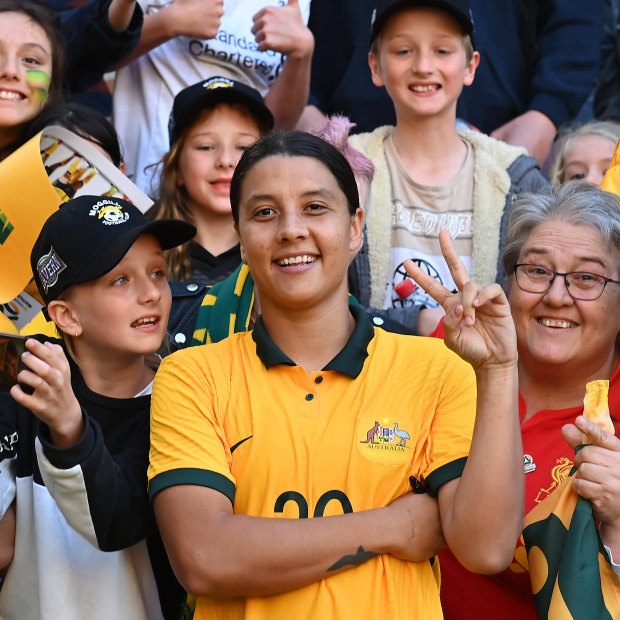
Sam Kerr poses with Matildas fans at a friendly against Canada in September 2022.Credit: Getty
For the duration of the FIFA Women’s World Cup, the Matildas will be based in Brisbane, and training at the Queensland Sport and Athletics Centre. It’s a fitting choice because the facility holds a special place in the team’s mythology.
In the opening ceremony for the 1982 Commonwealth Games in Brisbane, a 13-metre tall, six-tonne animatronic kangaroo built on top of a forklift rolled around what was known, back then, as the QEII Stadium. Her name was Matilda. She could wriggle her ears, turn her head and open her “pouch”, out of which 20 kids dressed as joeys spilled for a trampoline display.
Most memorably, she could blink her big, long eyelashes – and when she “winked” at Prince Philip, she became an instant Australian sporting icon, a symbol of the country’s cheeky irreverence and larrikin spirit.
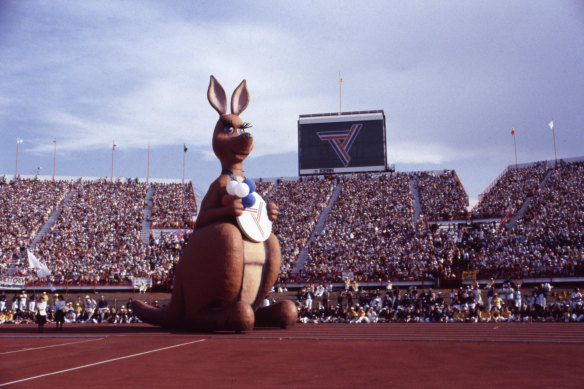
The famous ‘winking’ kangaroo named Matilda at the opening ceremony of the 1982 Brisbane Commonwealth Games. Credit: Vic Sumner
Only in recent years has it emerged, via the ABC, that the person in charge of her eye movement apparatus smoked a joint just before the festivities began.
You can draw a straight line from that extremely relaxed individual to the team that Sam Kerr will lead out onto Sydney’s Accor Stadium on July 20 for their opening match against Ireland – and it goes through four decades, seven FIFA World Cups, four famous words uttered by Juan Antonio Samaranch, an old classroom in Canberra, and a 25-cent phone poll on an iconic SBS television show helmed by Les Murray and Johnny Warren.
The remarkable story of how that towering kangaroo inspired the team’s nickname has never been told in full. It is a mini-history of the evolution of the women’s game in Australia, and how a volunteer-run labour of love – fuelled by lamington drives, community raffles and an army of self-funded players – overcame widespread ignorance and indifference to cement the Matildas as a cultural phenomenon and uniting force, which is about to enjoy its crowning moment.
‘Waltzing Matilda, we’re gonna kill you’
The Socceroos have been known by that name since 1972, when a publicity campaign for the team’s 1974 FIFA World Cup qualifiers coined the term “Socceroo”. It featured on a team logo unveiled by Sir Arthur George, the head of the Australian Soccer Federation, and was first deployed officially in plural form in a program for the visit of Scottish club Dundee United. With a push from Sydney journalist Tony Horstead, it quickly became widely used.
But for 16 years, from their first senior international fixture in October 1979 against New Zealand, the Australian women’s team was known only as: Australia.
That did not, however, stop others trying to come up with their own nicknames.
A book co-authored by Matildas pioneer Heather Reid, Women in Boots: Football and Feminism in the 1970s, lists some of the cringeworthy names conjured up by the press over that period, including the “Soccerettes”, “Lady Socceroos”, “Soccerbelles”, and even the “Jillaroos”, which is today used by the national women’s rugby league team.
One newspaper in New Zealand even called them the “Sexy Socceroos” during their 1980 tour.
Until a government review triggered the creation of the Frank Lowy-led Australian Soccer Association (later renamed Football Federation Australia) in 2003, women’s football was run by an entirely separate organisation to the men: the Australian Women’s Soccer Association (AWSA), which formed in 1974.
Charged with fostering the growth of the women’s game and running the national team, the AWSA sat in the shadows of men’s soccer – which itself was in the shadows of more dominant codes like Aussie rules, rugby league and cricket. This was many years before football became a mainstream sport, when it was still largely driven by post-war ethnic migration, and when finding the scores from matches played in England or elsewhere usually meant waiting for newspapers to be delivered from overseas, days after they’d been played.
Life on the margins meant the AWSA also had a miserly operating budget, which made national camps difficult to organise, let alone overseas fixtures. Players had to cover their own costs for airfares, uniforms and other fees, often resorting to fundraising efforts in pubs and clubs to find the money. When they did manage to play in another country, with no media coverage back home, they had to queue up at phone boxes to tell family and friends their results.
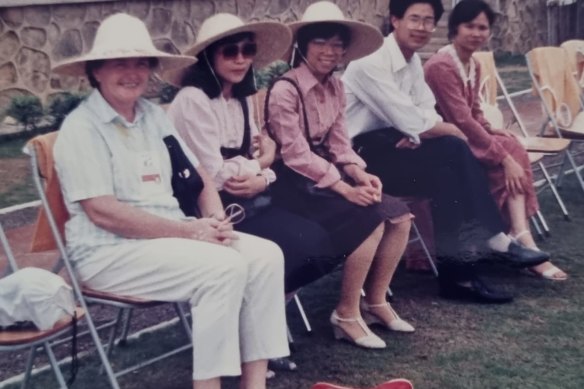
Elaine Watson (left), the former president of the Australian Women’s Soccer Association.Credit: Football Australia
In 1989, then-AWSA president Elaine Watson suggested the national team be called the “Soccertoos” – a portmanteau of “Cockatoos” with the idea that, yes, women play soccer too.
The need for a formally recognised nickname was always obvious – not just for marketing reasons, but to stop the media from using silly, sometimes disrespectful alternatives, or derivatives of the Socceroos, which rubbed players the wrong way. It was an occasional topic of conversation within the national team’s dressing room and, during qualifying for the inaugural FIFA Women’s World Cup in 1991, it came up again.
“They asked us for suggestions,” said Sharon Young, who played four ‘A’ internationals for Australia and, as best as this masthead can tell, deserves to be credited as the first person to float the eventual nickname.
“That’s when I said, ‘Well, what about Matilda? You know, the kangaroo that went around the stadium, the one that winked?’ I thought that’d be a great name.”
This was only nine years removed from the Commonwealth Games in Brisbane, which were still culturally resonant. The mascot had, obviously, taken its name from Waltzing Matilda, Banjo Paterson’s 1895 bush ballad, widely regarded as Australia’s unofficial national anthem – but Young is a bit miffed that people these days, including some of her former teammates, assume the name was directly inspired by the song.
“It actually was sung on the team bus,” said Moya Dodd, who played 24 times for Australia before becoming a leading football executive. Prior to being interviewed for this story, she was unaware of Young’s involvement or the mascot link.
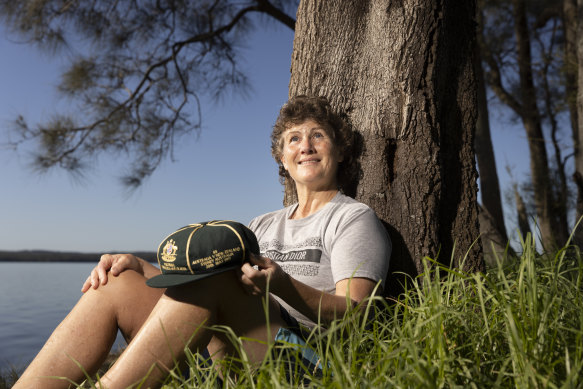
Sharon Young, the former Matildas player who came up with the idea for their nickname.Credit: Peter Stoop
“With a few adjustments to the words, as I recall. Something like: ‘Waltzing Matilda, we’re gonna kill you.’ I think all Australians have a connection with the song. People from overseas have said, ‘Why are you called the Matildas?’. And I’d say, ‘Well, there’s this song about a guy who stole a sheep and was running away from the English, and would rather die than get captured by the English overlords.’ And they’re like, ‘Oh.’
“I think it did capture a sense of rebelliousness, if you like, which is women’s football. It was banned for a long time. To be a woman playing football was a social transgression. In a way, it identifies well with a song about a guy who’s defying authority by stealing things, and then making sure he doesn’t get caught.”
But Australia ultimately failed to qualify for the 1991 World Cup, and the push for an official nickname ended there – shoved back “under the covers”, as Young put it, as her time with the national team also wound to an end.
“We obviously didn’t have the money like they had now. There was always lamingtons all over the house, trying to sell them, all different raffles to try and get me overseas. The disappointment of not making the first-ever Women’s World Cup, and actually go overseas, was a really big thing for me,” she said.
“You work so hard, and you get to that level ... I went through nationals with a broken toe to get into that team. It really affected me. I continued to play soccer at the state level, and I got in the Australian side again, but my heart wasn’t there, so I ended up retiring.“
Young went on to forge a distinguished career playing indoor soccer. But by far her biggest legacy was coming up with the “Matildas” name, which was now out there in the ether, and would soon take on a life of its own.
A ‘transformational’ moment
The trajectory of the women’s game in Australia changed dramatically through two seismic decisions made in September 1993. The first was when the International Olympic Committee agreed to include women’s football for the first time at the Atlanta 1996 Games.
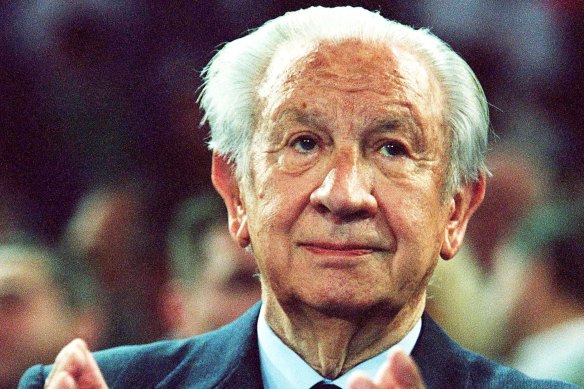
Juan Antonio Samaranch at the Sydney Olympics.Credit: Getty Images
The second was when Juan Antonio Samaranch stood up at the 101st session of the IOC in Monte Carlo, and said: “The winner is ... Sydney.”
At the time, the Matildas had never competed at a major international tournament outside of Oceania. Now, as hosts, they could look forward to a guaranteed shot at Olympic glory on home soil at Sydney 2000.
With women’s football on the Olympic program and hosting rights secured, a previously unimaginable level of government support was suddenly available, waiting to be unlocked by the AWSA.
Prior to joining the AWSA as their chief executive in 1994, administrator Peter Hugg was working at the Australian Sports Commission on the AOC’s “Gold Medal Program” – a government investment scheme to improve coaching, sports science, talent ID and high-performance programs across all Olympic sports so that, now that the Games were coming to Sydney, the host nation would win as many medals as possible.
Hugg was able to apply that knowledge in his new role. Suddenly, the AWSA’s annual funding skyrocketed from a meagre $50,000 to $1.3 million.
“It was transformational,” he said.
It enabled them to sign a full-time national team coach – Tom Sermanni – for the first time. Six intensive training centres for women’s football were set up across the country, and each had their own full-time coaches, too. The women’s game was booming – or at least the national team set-up was, in comparison to years gone by.
By winning the OFC Nations Cup in 1994, Australia qualified for the FIFA Women’s World Cup in Sweden the following year. Sermanni brought with him a full coaching panel, including an assistant, team manager, physio and a doctor.
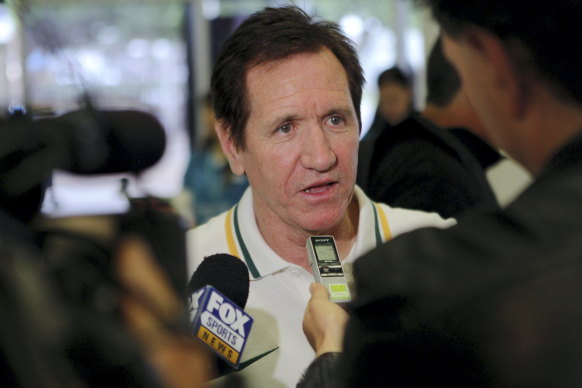
Tom Sermanni was the first full-time coach in Matildas history.Credit: Wolter Peeters
Still, with the tournament fast approaching, women’s football remained almost invisible in Australia, and that simply had to change.
“Very few people cared,” Hugg said.
“Those who did care [were from] a completely different demographic group. They were super passionate, but it hadn’t broken through to the mainstream. The term ‘soccer mum’ hadn’t even been invented yet. It was very much a boys game played by some older women, with the occasional girl playing in a boys team.”
One of the AWSA’s next hires was Sarah Groube, a fresh-faced university graduate who became their second full-time administrator, after Hugg, in 1995.
“We didn’t find it that easy to get into the media,” Groube said.
“The ABC was pretty good. You just had to pound the pavement though – we were literally ringing up Roy and HG on a Sunday to let them know what was happening in football, or trying to get on talkback. But no one was coming to us.”
The AWSA was trying its best, and it was around this time that it began throwing all sorts of ideas at the wall to boost crowds, interest and broader visibility of the national team. One of them was a failed attempt to deploy M People’s 1993 hit Moving On Up as a team song.
“We played it at matches,” Hugg said. “Some of the lyrics were ideal, and we thought, ‘this fits well’. But it was more about a relationship – girl meets boy, boy falls in love with girl, boy breaks up with girl, and then she leaves and she’s moving on up. It never caught on.”
As the media continued to refer to the team as the Female Socceroos, they quickly realised their best option was to come up with a name, once and for all, in time for the 1995 World Cup.
‘I’m not saying it was rigged’
The AWSA was based in Canberra, inside ACT Sports House – a primary school building in the suburb of Hackett that was converted into offices for many local and national sporting bodies. Hugg, Groube and Sermanni were working in an old classroom, brainstorming names for the national team with chalk on a blackboard, next to hooks mounted on the walls where schoolchildren would hang their bags, chewing gum still stuck on the floors and windows.
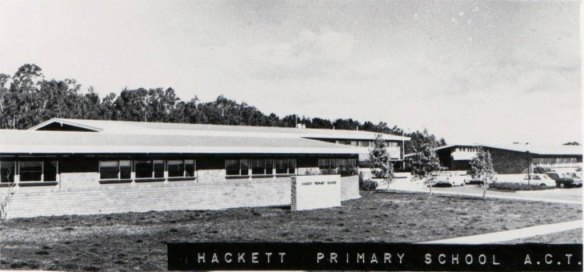
The old Hackett Primary School, which became ACT Sports House.Credit: Facebook
Groube never liked the idea of naming the team after an animal or object. “We just felt that if you name the team after something that already exists – like you might hear on the news if they’re talking about the Opals, but if you’re not really listening closely ... is that the basketball team or are they talking about actual opals?” she said.
After tossing up dozens of options, they kept coming back to one: Matilda.
”All the men’s teams – the Socceroos, Olyroos, Joeys – were about the kangaroo, so I guess what we were trying to find was the female version of the kangaroo,” Hugg said. They made the same link as Young had made to the 1982 Commonwealth Games mascot, albeit unaware she had floated it a few years prior.
Hugg looked up the meaning of the name Matilda, which was of German origin. “It means ‘mighty in battle’, so it ticked that box,” he said.
“We obviously had Waltzing Matilda, so it was a word that we were familiar with. Roald Dahl had written his book, Matilda, [published in 1988] about a girl with magical powers. And so these little snippets ... you sort of think, ‘This is getting a bit of legs to it. Let’s keep pushing this.’
“Sometimes you strike it lucky. It just fit. Nowadays, you would engage a strategist or an agency and some creative directors. It’s a lesson in that sometimes, the best ideas don’t cost any money.”
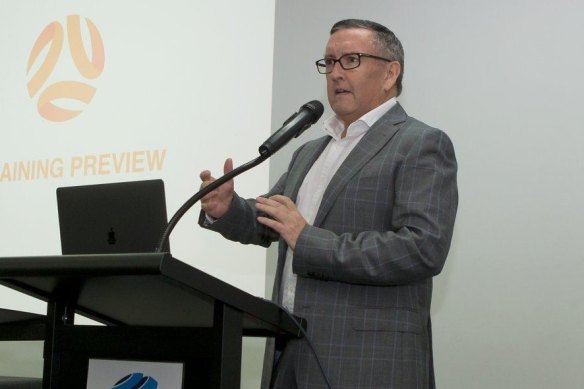
Former AWSA chief executive Peter Hugg.Credit: Football NSW
How this conversation leapt from the AWSA’s office to the studios of SBS and television screens across Australia isn’t entirely clear to anyone involved. Kyle Patterson, a presenter for On the Ball, SBS’s flagship football program that ran between 1984 and 2002, recalls a personal connection between Johnny Warren and Heather Reid, who at that stage was not officially involved with the AWSA but was working in Canberra for the Australian Sports Commission, and was always plugged into goings-on in women’s football.
Warren lived there, too, and Reid said he would frequent ACT Sports House to catch up with friends working for other organisations, which led to “random” chats in the corridor – and while she reckons this might have been one of them, she cannot remember the team’s search for a name coming up in a specific conversation.
Neither can Groube, although she was only a junior administrator, and said it may have happened above her head.
“I like the idea of it,” she said. “It could have played out that way.”
According to Patterson, Warren then brought it up during a production meeting.
“He said, ‘You know what? It’s about time we pay some attention to the women’s game because they’re committed. They do it for nothing. They do it for love.’ In the end, we went to the women’s association and said, ‘We want to help. This will get a lot of conversations happening. Are you happy for us to run this poll?’” Patterson said.
“They were great – they said ‘Yeah, we’re up for it.’ And they very quickly agreed that, within reason, they would accept the result as being the name. But we had to be very careful, because let’s be honest, it was a Sunday morning blokes’ show. We talked about the NSL [National Soccer League], it was pretty rough and ready.”
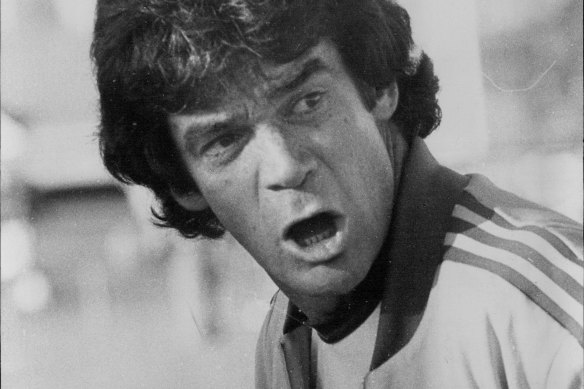
Legendary Socceroo Johnny Warren had a hand in how the Matildas got their name.Credit: Antonin Cermak
Groube said Warren was genuinely invested, and always supportive, like Patterson. But few others at the public broadcaster were.
“Even SBS, the real shining light for football, was not super interested in women’s football. It was still extremely ... well, sexist, I’d say,” she said.
“From time to time, we could get a bit of the novelty spotlight, and we had to keep using that throughout the 90s. That was what the competition was – it was, ‘Here we go, we might get some attention through running this competition.’ And it did. It got us some really great relationships built through SBS and some really great visibility.”
On the Ball’s involvement spanned over a couple of weeks. First, it put a call-out to viewers to send in their suggestions. Groube remembers a fax coming through from SBS with all the entries.
“Man, I wish I had kept the fax – [this was] back in the day when it wasn’t even coming through on single pages, it was this roll of paper, and it just kept coming and coming,” she said.
“I was in shock at how many entries there were ... Cockatoos, and all these animal names. We all just went, ‘Nope, we’re not gonna be named after something.’ I don’t know if [SBS] filtered some things out – I just remember reading some pretty tasteless ones, and going, ‘You’ve got to be kidding.’”
Among the entries were the Galahs, and even – gulp – the Sheilas. “I mean, it’s wrong. It just wouldn’t have lasted,” Hugg said.
From there, the AWSA narrowed it down to five names. There was the Waratahs, the NSW floral emblem, which was already in use by the state’s rugby union team, and would have been unpopular with players and fans from elsewhere. The Blue Flyers, which is the name for a female red kangaroo, but a bit too abstract. The Lorikeets, a rainbow-coloured parrot native to Australia, but potentially a bit too cute and cuddly for the sporting arena. The Soccertoos, somehow, survived to the final ballot.
And then, the Matildas.
Patterson read them out on air, encouraging viewers to dial into a 0055 number to cast their vote, at a cost of 25 cents per call.
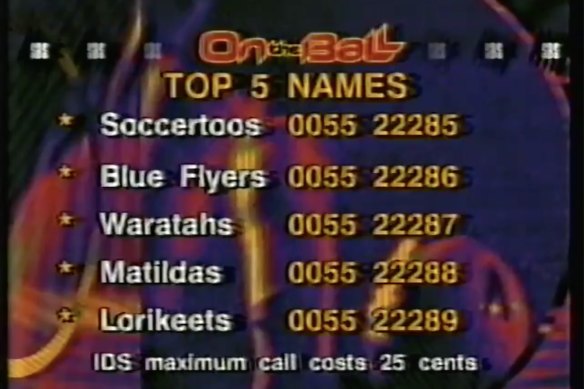
The SBS phone poll that led to the Matildas getting their name.Credit: SBS
The final five names were, as Hugg explained, carefully selected.
“You don’t run a competition unless you can influence the outcome,” he said.
“I’m not saying it was rigged. But I’m saying it was skewed. And if you look at some of the names that it was up against ... you take the result that you want, and make all your other options not so attractive.”
The Matildas won by a landslide. Sermanni distinctly remembers driving from Canberra to Sydney on a stormy day when he received a call from someone at SBS with the results, straining on his brick-sized mobile phone to hear the person on the other end as torrential rain pounded his car.
“There was no other name that came close,” he said. “But to be honest, I wasn’t that fussed by it. I was like, ‘I’m not sure about this.’”
‘Girls need heroes too’
These days, it’s hard to imagine the Matildas being called anything else. According to subsequent newspaper reports, some players were apparently unhappy with the outcome, but nobody we spoke to could remember any sense of disquiet within the team, or any particular individuals at the source of it.
“I have to admit, if there was concern or consternation or doubt, I never heard it,” Hugg said.
“But this is before WhatsApp, chat groups, social media. They may come together at camps or whatever, there might have been some discussions, but there certainly wasn’t a player rebellion. It’s been so successful, it’d be a very game player to say, ‘I never liked it.’
“I would do it differently today. I have to confess, I don’t think we consulted the players as much as we probably should have.”
According to an independent study by Futures Sport and Entertainment, the Matildas are now Australia’s fourth-favourite national team and climbing. They have become a household name, internationally renowned, although precisely when they wormed their way into the public consciousness is up for debate – Reid suspects it wasn’t until players posed for a controversial nude calendar on the eve of the Sydney Olympics, which is a whole different story, and a textbook example of the sort of gimmicks they still had to resort to for coverage until very recently.
In typical Australian style, the Matildas is now regularly shortened by fans and players to the Tillies. Other national sides like the Young Matildas (the under-20s) and ParaMatildas (the cerebral palsy team which was launched in 2022) have also borrowed their name.
Young is thrilled her idea has aged so gracefully, and has to thank her father, GEOFF, for the fact her involvement became public knowledge. He blurted it out in a 2016 interview with a local newspaper in Laurieton.
“He was just talking to a journalist there and says, ‘Oh, you know, my daughter, she came up with the Matildas name.’ She goes, ‘Well, that’s a good story.’ And I didn’t know anything about it until she rang me and started asking me all these questions,” she said.
“I said, ‘Well, that’s right. I’m glad he remembered.’ Because I never said anything to anyone – you don’t think about all that stuff. But dad remembered. Unfortunately, he’s got dementia – I’m his carer, I look after him now. But he always sits up with me and watches Matildas games, he still loves the soccer, whatever it is, men’s or women’s.
”It’s great. You talk to anyone now, they know the Matildas. Once we have this World Cup here, then it’s really going to put it on the map and everybody’s going to be shocked at how many people are involved and how many people watch it. I’m so proud that it’s got that far and so proud to be a pioneer of that era were back in the day.”
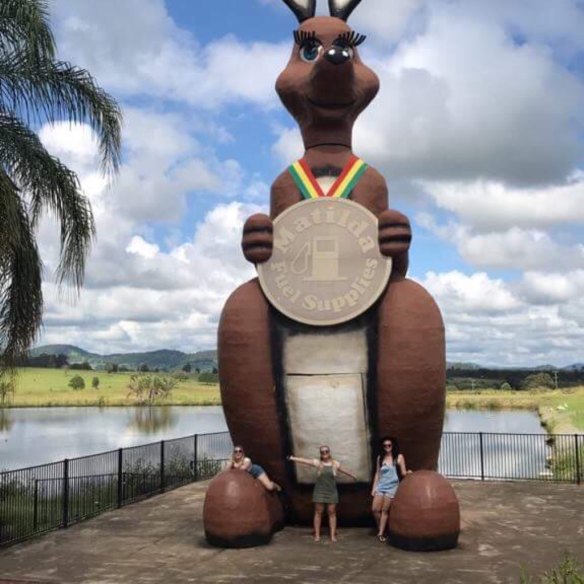
Matilda the mascot, from the 1982 Commonwealth Games, now lives at a fuel station in south-east Queensland.Credit: TripAdvisor
As for Matilda the mascot? She’s had an itinerant life. Two years after the 1982 Commonwealth Games, she moved an hour down the road to the Gold Coast, where she sat at the entrance to the Wet ‘n’ Wild Water World (then known as Cade’s County Waterpark) – until 2009, when she was bought by Matilda Fuel Services, who put her up at a petrol station in Kybong, and then when that was demolished, another in Traveston, where she lives today.
Hugg, meanwhile, is now based in Saudi Arabia, and still works in football, but travels the world when he can to watch the Matildas, and will be coming home to cheer them on at the World Cup.
“Tommy and myself and the board and others, we played only a small part. The Matildas name ... it’s because of what the players have made it,” he said.
“It’s grown a life as a result of every player who has put on the shirt. I get a bit emotional because I’m very patriotic, and I love the team.
“My daughter was born at the end of ’94, so she’s the same age as the name. When you become a father, and particularly of a daughter, you suddenly care about the world that she’s going to live in. I was a football administrator who wanted to provide a better world for my daughter.
“Girls need heroes too. We wanted to create heroes out of these girls. What we wanted to do was exactly what’s happened. When you go to a Matildas match, and you see a six or seven or eight-year-old walking around with [Chloe] Logarzo or Kerr [on their back] or putting Hayley Raso’s ribbons in their hair – I mean, that has to be the ultimate, doesn’t it?
“The girls are so wonderful, they are such a joy, and I love them all dearly.”
News, results and expert analysis from the weekend of sport sent every Monday. Sign up for our Sport newsletter.